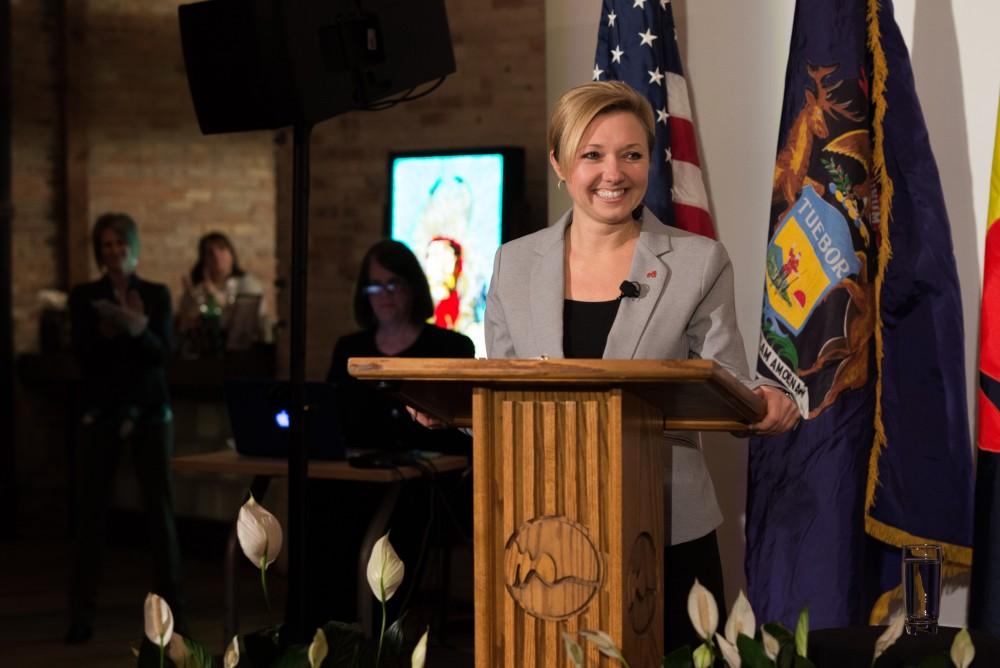Mayor Bliss delivers Grand Rapids State of the City address

GVL/Luke Holmes Mayor Rosalynn Bliss speaks on stage from the podium. Mayor Bliss held her first State of the City Address Tuesday, Feb. 2, 2016 in downtown Grand Rapids.
Feb 4, 2016
On Jan. 1, Grand Rapids Mayor Rosalynn Bliss began her term as the city’s first female mayor. After serving the previous 10 years as Second Ward City Commissioner, Bliss was welcomed into the mayoral spot after receiving well over 50 percent of the vote.
As is tradition with the mayors of the city, Bliss gave her first State of the City address on Feb. 2 inside the historic Harris Building on Division Avenue.
“She’s worked in every corner of this city, every neighborhood, at every level of government,” said Teresa Weatherall Neal, superintendent of Grand Rapids Public Schools. “She has dedicated her life to helping others.”
Bliss’ address, which was put on with the help of many community partners and small businesses, focused on the people of Grand Rapids and the importance of community to the city.
“The people are the heart and spirit of our city,” Bliss said. “People have stepped up again and again to make Grand Rapids what it is today.”
Grand Rapids is a city that is constantly growing and changing, and Bliss said that is intentional, and she hopes to continue that growth.
“In a sense, you can think of the progress that we’ve made in our city like a tree,” she said. “Our city has deep roots and we have built a strong foundation. Just like a tree, we are growing, expanding and branching out. ”
Bliss reiterated former Mayor George Heartwell’s idea of keeping Grand Rapids moving forward and establishing the city as a hub for action in the state.
“I want Grand Rapids to be the place,” she said. “I want us to be a city that nurtures hope, innovation, inclusion and a sense of possibility. We are the bright spot in Michigan.”
Bliss’ goals for the city are reminiscent of Heartwell, with a large focus on education, mostly improving elementary school performance throughout the city, the environment, by continuing to make Grand Rapids a greener city and combining the two through a collaboration with GRPS to increase environmental education in schools to increase children’s access to nature.
Bliss, while looking forward into Grand Rapids’ future, did not hesitate to talk about the city as it is right now. She praised the city for all the hard work that has been done in the past.
“We have a spirit in Grand Rapids that believes that anything is possible,” Bliss said. “It is this opportunism that is in our DNA and is yet another trait that makes our city great.”
In addition to improving the neighborhoods, Bliss touched on better police-community relations, making housing affordable for everyone in the city, and doing a better job in combatting homelessness.
Bliss said that she wants to tackle the hard projects, like racial disparity in Grand Rapids.
The typical black household earns less than half that of a white household in Grand Rapids, and 42 percent of black people living in the city are living in poverty, almost four times of the white population living in poverty.
It’s not just black residents. 35 percent of Hispanic residents of Grand Rapids live in poverty, with unemployment at 27 percent.
“A tree will sprout many branches, in many directions, but it can still be fundamentally unhealthy if careful attention is not paid,” Bliss said. “We must confront a difficult issue that has grown to an unacceptable proportion in our community.”
Through implicit bias training and cultural competency, Bliss is optimistic that working together will change the disparity between races in the city.
Bliss acknowledged that Grand Rapids has come a long way from the city that it once was, due to continuous work from former elected officials, and knows her goals are not attainable without working together as a city.
“I believe we can establish a common goal and we can make a lasting positive change,” Bliss said. “We build on the efforts of those who came before us and enlist the help of those who can be a constructive force going forward. In our community, we work together in collaboration, in partnership, to accomplish great things.
“Together, we are Grand Rapids.”

























